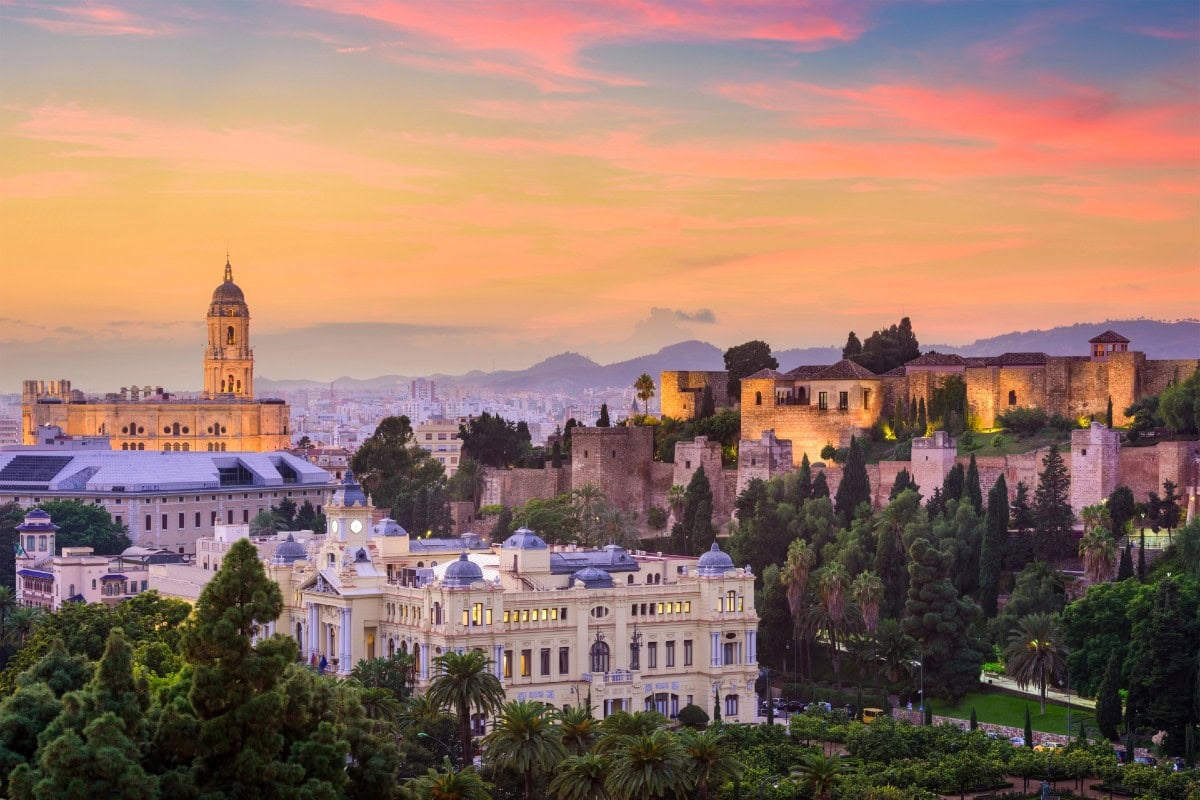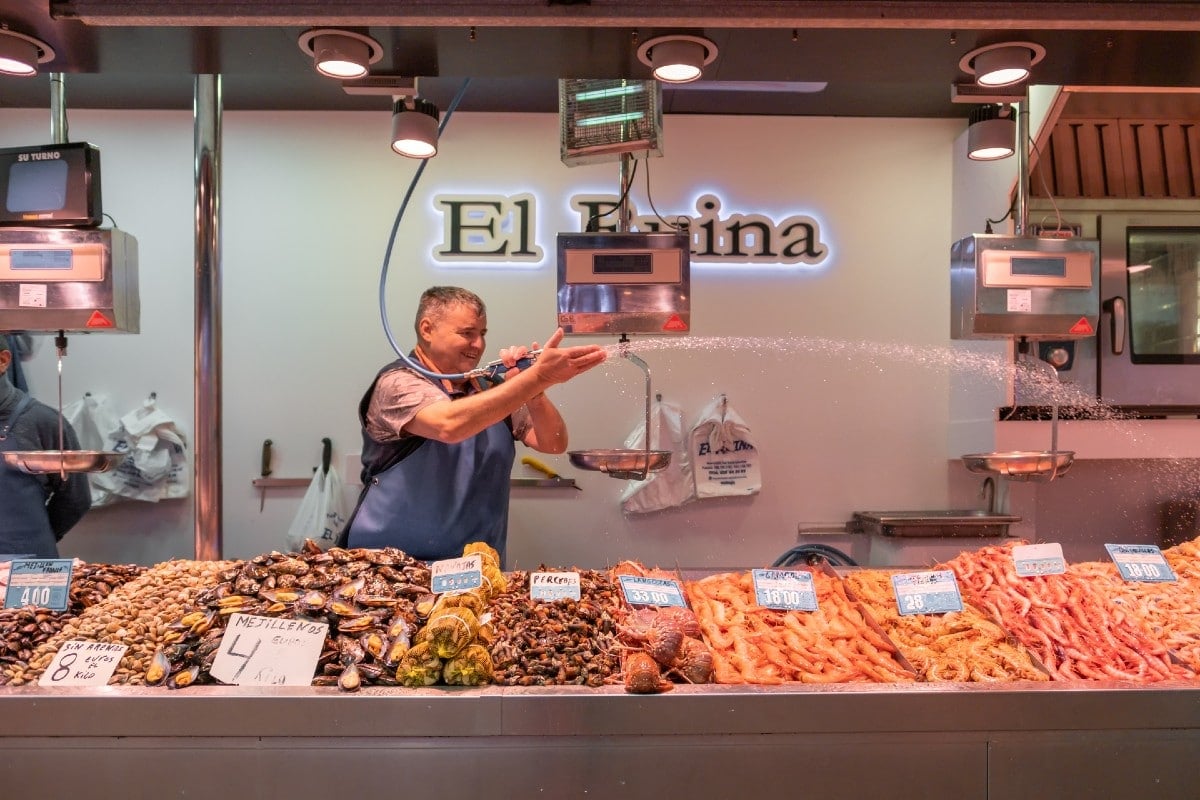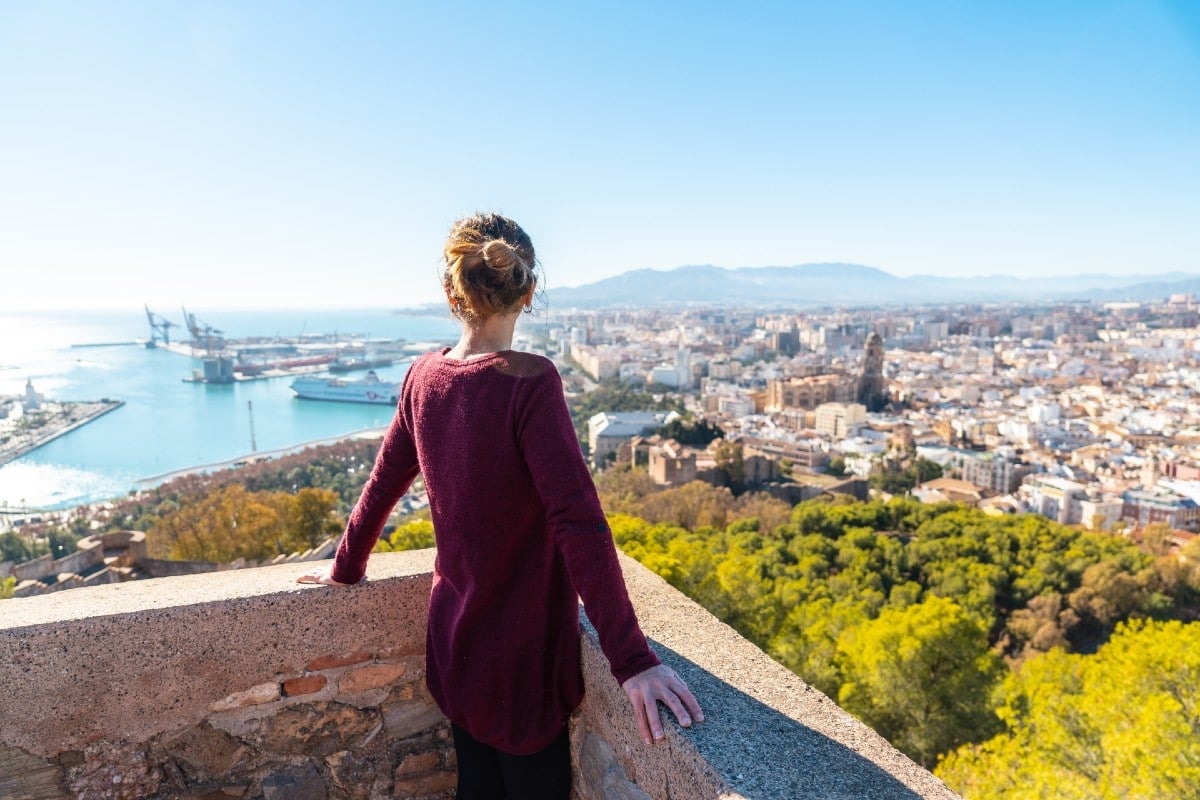Our City Living Guide series covers the practical and emotional journey of moving to a Spanish town or city. With the observations of Expats this combination helps you feel what it’s like to live there and — crucially — gives you confidence in making your ‘moving to Spain’ decision.
Gateway to the Costa del Sol
Along with its Andaluz cousin, Cádiz, Málaga is one of Western Europe’s oldest continuously inhabited cities. Founded around 770 BC by the Phoenicians as ‘Malaka,’ it was a commercial enclave later influenced by Greeks, Carthaginians, and Romans, who renamed it Flavia Malacita. The Moors took the city in 743 and transformed it into a flourishing town until Catholic Monarchs ended Moorish rule in 1487.
As the old English Cemetery ( the oldest Protestant Cemetery in mainland Spain) attests, Europeans have been settling here for a considerable period.
The place has history!
Geography
Located in the south of Spain, the city is the capital of its province of Málaga, located within the autonomous community of Andalucía. Málaga is part of the Costa del Sol and lies about 100km east of Gibraltar.
Málaga
Málaga is often thought of as the airport or train station you pass through on your way to the Costa del Sol. However, living in Málaga is a journey in itself. Like many cities in Spain, it is unique and has been described by our Expat experts as a ‘hidden gem.’ If you’re looking for a genuine Spanish life experience, Málaga is a ‘must look at’ consideration.
Population:
City: 590,000
Málaga Province: 1.75M
Autonomous Community: Andalucía
Useful links
Ayuntamiento de Málaga
Facebook: Expats in Málaga City
Real Estate: Idealista
The city’s terrain is characterized by the valleys of the Guadalhorce and Guadalmedina rivers, with its center situated between the Monte Gibralfaro hill and the Guadalmedina River.

Expat Insiders:
Sean Miller & Claire Twigger
Sean from New Zealand and Claire from the UK met and married in the UK. After living in Switzerland for a while, in 2020, they decided to move to Spain (Claire had previously lived in Barcelona).
Sean is a life coach and Claire is a freelance translator.
tuneyourlifecoaching.com
Climate
The Montes de Málaga mountain range provides a natural geographical barrier, influencing the city’s Mediterranean climate with moderate temperatures.
Climate change means that temperatures are rising consistently year on year. This is leading to less rain, resulting in water shortages and rationing. It also contributes to severe storms that occur occasionally.
“Be prepared for heat and not having a winter!” says Sean.
Population
Málaga city and the province have experienced significant population growth in recent years. The city’s population reached 587,068 in 2023, while the province has 1.75 million inhabitants. The area attracts a large foreign population, with 85% of new residents in 2022 being of foreign nationality. The British community is particularly prominent, numbering over 50,000. By age, the 40-65 group saw the most significant increase, followed by those over 65.
Sean encapsulates Malaga as:
“A fantastic combination of history, culture, cuisine, and climate, all contained in a size and population that is not overbearing. Its seaside location is both enticing and easy to get to. It is truly the gateway to the Costa del Sol and Andalucía.”

Living in Málaga: Daily Life and Community
Living in Málaga is a vibrant and welcoming experience for Expats. The city’s daily life, community spirit, and ease of integration make it an attractive destination for those seeking life at a relaxed Mediterranean pace.
Málaga blends modern amenities with historical charm against a backdrop of beautiful beaches and lush natural surroundings.
Community Spirit: Integration and Belonging
In their nearly five years in the city, Sean and Claire have always found the people warm, open, and friendly people. Furthermore, the place feels very Spanish. “Living in Malaga, you definitely feel like you are part of an authentic Spanish city and not part of the expat community living in the Costa del Sol,” says Claire. “Once over the bureaucracy, you have time to enjoy the people here. You quickly feel part of the community.”
Settling Down: Housing and Neighborhoods
The city’s welcoming atmosphere and varied neighborhoods appeal to different groups. However, the growing real estate prices and competitive rental market may present challenges.
“It Is growing, both in terms of permanent residences and tourism,” says Claire. “This brings related challenges, including price increases and a crowded central city.
“In our view, when looking for accommodation, Malaga East is traditionally more upmarket, while Malaga West is developing from its more traditional roots.”
Your Spain Move Planning Package
No guesswork. Just expert guidance tailored to your situation. Our packages include one-on-one consultations with immigration, tax, and finance specialists—plus access to essential moving tools and direct support from Alastair and Alison.
Real Estate Market
The real estate market in Málaga is booming. Average property prices reached €3,175 per square meter in October 2024, a near 20% increase from the previous year.
Renting
The rental market is also experiencing rising costs. The average rent per square meter in the city center reached €15.30 in May 2024, with an overall average of €14.60/m2, up 7% from 2023.
Typical Rental Costs in Málaga
| Neighborhood | Property Type | Area | Bedrooms | Typical Monthly Rent (€) |
|---|---|---|---|---|
| Centro Histórico | Apartment | City Center | 1 | 750-1100 |
| 2 | 1000-1500 | |||
| 3 | 1300-2000 | |||
| La Malagueta | Apartment | Beachside | 1 | 800-1200 |
| 2 | 1100-1600 | |||
| 3 | 1400-2200 | |||
| El Limonar | House | Suburbs | 2 | 1200-1800 |
| 3 | 1500-2200 | |||
| 4 | 2000-3000+ | |||
| La Trinidad | Apartment | Historic Area | 1 | 650-900 |
| 2 | 800-1200 | |||
| 3 | 1000-1500 | |||
| Teatinos | Apartment | University Area | 1 | 600-800 |
| 2 | 750-1100 | |||
| 3 | 900-1300 | |||
| El Palo | Apartment | Beachfront | 1 | 700-1000 |
| 2 | 900-1300 | |||
| 3 | 1100-1600 |
Selected Málaga Neighborhoods at a Glance
| Neighborhood | Resident Profile | Characteristics |
|---|---|---|
| Centro Histórico | Mix of tourists and locals, vibrant urban lifestyle seekers | Historic center, cultural attractions, lively atmosphere, limited parking |
| La Malagueta | Beach lovers, families, and those seeking coastal living | Beachside, luxurious amenities, close to city center, vibrant |
| El Limonar | Affluent families, luxury seekers | Exclusive residential area, tranquil, sea views, upscale properties |
| La Trinidad | Local community | Historic, vibrant social scene, close-knit community |
| Teatinos | Students, young professionals | University district, modern amenities, youthful vibe |
| El Palo | Families, retirees, traditional community | Beachfront, traditional fishing village feel, strong community spirit |

Essential Considerations
Employment Opportunities
The service industries dominate the employment scene, particularly tourism. The locals generally welcome tourism as they appreciate the revenue it generates. Agriculture is another big player, especially olive oil production.
Málaga outperforms many Spanish provinces in job creation and unemployment reduction, making it a standout in the regional and national context. Its unemployment rate has dropped to 12%, its lowest level ever, and a record 50,400 new jobs were created in the second quarter of 2024. The hospitality, administrative services, and construction sectors have driven this.
In parallel, Málaga’s youth employment has improved significantly, with a halved unemployment rate and increased vocational training enrolment. Government initiatives and overall job growth have spurred this.
The Parque Tecnológico de Andalucía (PTA — Andalucia Technology Park) is a large tech hub and IT support center. It hosts nearly 700 companies — including multinationals such as Google, Ericsson, Accenture, Telefónica, and Vodafone — and employs around 25,000 workers. It also generates almost 20% of Málaga’s GDP.
The PTA is strong in the Information and Communication Technologies sector and attracts many digital nomads to Málaga.
Daily Routine and Work-life Balance
Malagueños work to live. There is a carefree attitude to life, which is reflected in the constantly busy cafes and restaurants. The locals are very proud of their city and warm-hearted natures and often draw differences between themselves and the ‘inlanders’ from Seville and Granada, who they see as austere.
“It is a good-sized city not overrun by tourists,” says Claire. “Yes, it is growing quickly, but not too quickly. It would be difficult to turn it into a resort,” she adds.
Bureaucracy and Paperwork
Spanish bureaucracy in Málaga can be challenging for expats (and locals). It can be slow — wait times for documents like TIE cards can be up to six months — with complex paperwork, but it’s no different in many Spanish cities.
Patience is crucial when dealing with administration, and our advice is always:
‘Go with the system, don’t fight it.’
And it is strongly recommended to enlist the services of a gestor or appropriately qualified expert to help you.
Find Your Perfect Property in Malaga
The Málaga property market can be tough to navigate, especially from afar. Our housing expert in Malaga Carin, will work exclusively for you, providing personalised advice, bilingual support, and access to off-market properties.
Transportation and Getting Around
Largely thanks to tourism in the Costa del Sol, Málaga has fantastic travel links to the rest of Spain, Europe, and the US. Sean says: “The city is still small enough to be easy to get around cheaply with an excellent local public transport system.”
The metro system (single fare: €1.40) has two lines connecting the university area to the city center and the western part of the city. The bus network (single fare €1.35) has over 40 routes, and local suburban trains link Málaga to coastal towns and inland areas.
The Málaga Area Metropolitan Transport Consortium (Consorcio de Transporte Metropolitano del Área de Málaga (CTMAM)) offers a rechargeable Green Travel Card for use within the Málaga metropolitan area. This gives discounted fares on CTMAM transport, including local and long-distance buses, metro, and suburban trains. It costs €1.80 at tobacco shops, bookstores, and other authorized locations. Additional services include tourist buses and airport connections, making moving around easy.
The María Zambrano rail station is a hub for the high-speed AVE trains and connects the city to Madrid, Córdoba, and other major Spanish cities, while Málaga-Costa del Sol Airport is Spain’s fourth busiest, handling over 22 million passengers annually. It is the main entry and exit point for the Costa del Sol and Andalucía and connects to over 60 cities worldwide. Claire observes:
“You can fly to just about anywhere in Europe.”
In 2024, the airport enhanced its connectivity to the US, with United Airlines operating a daily non-stop service between Málaga and New York/Newark from May to September. Local authorities are working to extend the direct flights year-round.
Shopping and Amenities
Shopping amenities in Málaga are comprehensive, with most centers providing wheelchair accessibility, parking, and children’s play areas. Many are LGBTQ+ friendly, offering transgender-safe spaces.
The shopping experience is a diverse combination of modern retail centers and traditional markets. Shopping malls include the Larios Centro, Vialia Centro Comercial, and Muelle Uno, an open-air complex along the waterfront. These feature a mix of fashion boutiques, restaurants, supermarkets, and entertainment options like cinemas and casinos.

For a more traditional experience, markets such as the Mercado Central de Atarazanas and Mercado de Salamanca offer fresh produce and local specialties in historic settings.
Málaga Cost of Living
While it is considered to be one of the more expensive cities in Spain (with the increase in tourism increasing costs), Málaga is still a comparatively cheap place to live. It also offers a distinctly lower cost of living than the country’s most expensive cities, such as Madrid, Barcelona, and Valencia.
Typical Living Costs in Málaga
| Item | Typical Monthly Cost (€) |
|---|---|
| Cost of Living: Single person (including rent) | 1520-2000 |
| Without Rent | 580-700 |
| Utilities (Electricity, Heating, Water and Waste) Standard Apartment | 90-140 |
| High-Speed Internet (50 Mbps) | 30-35 |
| Meal for One: Inexpensive restaurant | 13-15 |
| Dinner (three-course) for Two: Mid-range restaurant | 55-60 |
| Groceries: Single Person | 250-390 |
| Gym Membership | 30-40 |
| Cinema Tickets | 8-10 |
Education in Málaga
Málaga’s education system provides a comprehensive range of options from early childhood to higher education, with a strong emphasis on bilingual education and international curricula in many private institutions.
Notable private schools include the British School of Málaga and Salliver School (in nearby Fuengirola), known for their bilingual education and strong extracurricular programs. The city also boasts several bilingual schools, like NovaSchool Sunland International, offering curricula in Spanish and English.
Higher education is centered around the University of Málaga (UMA), ranked 23rd among Spanish universities. With over 35,000 students, UMA offers various programs across faculties, including Engineering, Health Sciences, Arts and Humanities, and Economics. The university is affiliated with the Parque Tecnológico de Andalucía.
Health Services
The public healthcare service is part of the Andalusian Health Service (SAS) and provides universal care. Residents contributing to social security have automatic access. The system boasts a high healthcare index of 70.76, although there are challenges with waiting times. There are numerous medical centers (centros de salud) for primary care and hospitals such as the Hospital Regional Universitario de Málaga.
Private healthcare — with hospitals like Quirón and CHIP — offers faster access to specialists. Private health insurance (mandatory for some visas) is affordable and often complements public services. Sean and Claire combine private health insurance with the public system (which Sean has used for surgery).

Living Like a Local
According to Sean and Claire, Málaga differentiates itself from the rest of the Costa del Sol. It retains a very Spanish feel along a coastline usually known for tourism and its British, German, Dutch, and other European groups.
Málaga is a busy city with a port hub comprising bars, clubs, and restaurants that create a fantastic atmosphere. The cruise ships that dock daily add another layer to the vibrancy.
So much to do!
Even after nearly five years living in Málaga, “it feels like you are on holiday every day!” says Sean. “We have done so much from discovering the old fishing barrio of Pedregalejo and visiting the many close by ‘white’ villages to learning and performing flamenco in public and simply sitting in a chiringuito in December in a T-shirt watching the Med.
“And we haven’t really scratched the surface. We want to join a walking club and a golf club, visit more museums, ski in the Sierra Nevada, and learn more about olive oil!”
A Taste of Life: Food, Festivals, and Traditions
Arguably, Málaga is best experienced through its food, festivals, and traditions. The city’s culinary scene boasts delectable dishes like ajoblanco, a cold almond soup, and espeto de sardinas, skewered grilled sardines. Local specialties such as porra antequerana and ensalada malagueña, salted cod, and orange salad reflect the region’s rich gastronomic heritage.

And the manner of eating is an experience in itself. Sean says: “Lunches with the locals are invariably a six-hour engagement! And we love eating at 10pm in crowded mesons and seeing the city full of life well past midnight.”
Festivals punctuate the calendar, with the lively Feria de Málaga in August and the solemn Semana Santa processions during Easter. The Málaga Carnival brings colorful parades and music to the streets.
“Semana Santa processions are like stepping back in time,” says Sean.
In June, the Night of San Juan sees picnics and bonfires on the beaches till the early hours. These celebrations and the warm hospitality of locals create an unforgettable tapestry of Malagueño life.

Leisure and Recreation
Málaga offers a diverse range of leisure and recreation options. The climate, with its warm temperatures and abundant sunshine (320 days of it!) throughout the year, allows for an outdoor-oriented lifestyle. You can enjoy the city’s stunning beaches, perfect for swimming, surfing, and paddleboarding. The nearby Montes de Málaga Natural Park provides excellent hiking and mountain biking trails. Activities like canyoning and rock climbing in El Chorro Gorge are available for thrill-seekers.
The Sierra Nevada is only two hours away, and skiing in the winter is usually possible. If the weather is right and you get organized, you can ski in the morning and swim in the Mediterranean in the afternoon!
Arts and Entertainment
As the birthplace of the artist Pablo Picasso, it’s no surprise that Málaga boasts a lively arts and entertainment scene. The city offers numerous museums, including the Picasso Museum, Centre Pompidou Málaga, and the unique Automobile and Fashion Museum. At the same time, La Térmica serves as a cultural hub for various art forms.
Music festivals, theater performances, and film screenings are common. The city also embraces street art, particularly in the Soho district, transforming it into an open-air gallery.
Social Life and Community
Málaga is home to warm, friendly people with a deep sense of tradition and culture. The locals are welcoming, making it easy to feel at home. Integrating into the community is easier by embracing the local way of life. “Joining a club — whether it’s a gym, golf, hiking, or another leisure activity — is a great way to meet people and build connections,” advises Sean.
On the flip side, Málaga can feel “provincial” at times. While the city is vibrant and modern in many ways, attitudes toward sustainability, climate change awareness, and recycling can seem behind the times. Additionally, some Expats notice concerning attitudes toward animal welfare, which may differ from what they’re accustomed to.
To truly enjoy Málaga, adopting the Spanish pace of life is essential. Things do get done, but they move slower. That’s part of its charm!
Expat Community
There are established and lively Expat communities in and around Málaga. At the same time — and even though they are not really active in an Expat community — Sean and Clair believe that, like themselves, Expats tend to be reasonably well integrated into Spanish life. The Expats In Málaga City Facebook page is an excellent resource for local insider tips.
Need help with your Spain visa or residency?
We partner with two highly rated, English-speaking immigration law firms in Spain — each thoroughly vetted for excellence in service, professionalism, and client satisfaction. Schedule a 30-minute consultation with them to explore your best options, understand the process, and get personalized answers to your questions.
Learning and Speaking Spanish
Unlike other regions in Spain, Andalucía doesn’t have its own recognized language. However, the Andaluz accent can be difficult to understand (as Spanish people from different parts of Spain have told me). The accent is characterized by several unique traits, such as softer pronunciation compared to northern Spanish dialects and occasional dropping of ‘s’ or ‘d’ sounds at the end of words.
However, it’s worth noting that the accent in Málaga City is generally less pronounced than in rural areas, making it easier for Spanish learners to understand
Our advice to anyone considering moving to Spain remains: having at least some basic Spanish when you move to Málaga is very helpful. Even though it’s in the tourism-dependent Costa del Sol, most people living in Málaga do not speak English. “It’s hard to get by without the basics,” says Sean. And, of course, once there, you can continue learning in situ, arguably the best way to pick up the language.”
READ ALSO >>> Living in Andalucía
Is Living in Málaga for You?
If you embrace life at a relaxed pace, love exploring your environment, and immersing yourself in a rich culture, Málaga must be on your list.
Sean and Claire cannot be clearer:
“It is the best place in Europe to live.”
Equally, they cannot emphasize enough that Málaga is different from the rest of the Costa del Sol. “It’s wonderful to have the best of both worlds. We live in a lovely Spanish city with access to the Costa del Sol and Andalucía. Because we are surrounded mainly by locals, we also get a unique, fascinating, and educational insight into Spanish culture. It has certainly broadened our minds and encouraged us to learn more about not only Spanish history but also world history.

“It is so relaxed here. And because of the geographical location and the easy-going local culture, the days seem to last much longer. You feel you have more and a richer life.








